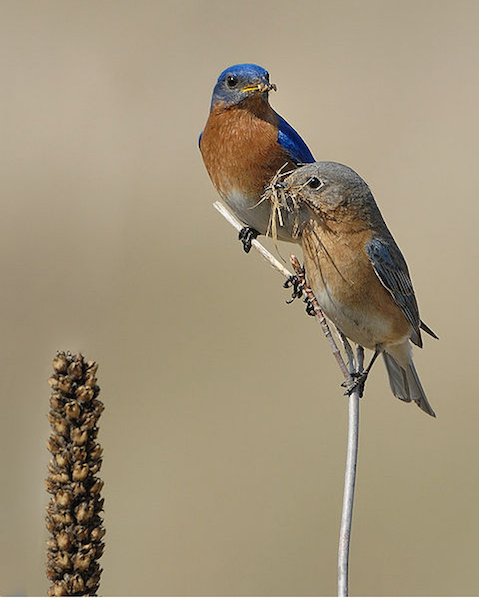Thanks, Dad, for the memory leading to the post title…
I must confess that I miss having a Birds and Butterflies Chair. I know of at least one of our ladies who really goes all out to attract birds in her yard and whose husband takes wonderful photos of them (yes, Julia) and I am filled with admiration for this dedication. The rest of us make some effort– planting berried shrubs and/or at least fill birdfeeders (that are raided by persistent squirrels).
One bird that many will bend over backwards to attract is the Bluebird. Due to habitat loss and nesting site competition from aggressive Starlings and English Sparrows, the population has seriously declined. Luckily, because the Bluebird has been aided by a great birdhouse building effort, its numbers have been slowly improving. However, climate change will continue to strongly affect habitat , especially for Mountain and Western Bluebirds.
The main spot to view bluebirds from my house is when they are on the wires. My front yard used to be an 8 acre hillside meadow, but is now a patchwork of suburban grassy yards with scattered clumps of trees and shrubs. However, this sort of semi-open habitat is acceptable for our Eastern Bluebird. Grandma used to put Bluebird boxes all along the cow lane.
Their diet consists of many kinds of insects, some caught in flight. Other ground dwelling insects (and worms or snails) are also fair game. If you see a bird fluttering low and hovering without actually landing to get a bug, it may well be a Bluebird. Bluebirds also love to eat berries: flowering dogwood, eastern red cedar, holly, and pokeweed. They also will eat elaeagnus, barberries, privet, cotoneasters, cherry laurel, honeysuckles, multiflora rose and mulberry. Note how many of those are invasive species… In winter they *may* eat suet.
In central and eastern Maryland, Bluebirds may be found year round, but as one moves from Carroll to the western counties, the population is more of a breeding season one. As cavity nesters, Bluebirds are not averse to using old woodpecker holes or crevices, generally at levels up to 20 feet above ground. The females build small cups of grasses, leaves and twigs (sometimes with hair or small feathers) and lay 3-7 pale blue, unmarked eggs. (This egg coloration is how to tell if an Sparrow or Starling invader has taken over a bluebird nest.)
If you build or adapt a premade nest box for Bluebirds, be sure to add a predator baffle.
Audubon’s Specs for a DIY Bluebird Box
One interesting thing I read is that over the approximately 3 week period while fledglings are in the nest, the previous hatchlings may assist the parents in feeding their siblings. That’s pretty cool…



